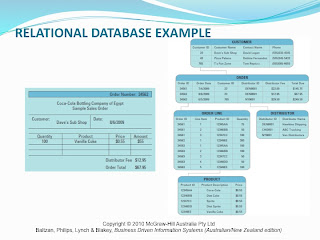- Accuracy: Is all the information provided correct? For the information to be accurate it must have all the correct information, such as the correct spelling of names and correct numbers used.
- Completeness: Is all teh information needed, provided? Are all the numbers provided for a phone number including area codes, does the address have all the relevant information.
- Consistency: Is all the information consistent throughout the form? Do totals correctly represent the total of individual amounts.
- Uniqueness: Are all the transactions recorded only once or are there duplicates? Has a customer been entered into the system twice?
- Timeliness: Is the information provided up to date with the requirements of the business? does the information need to be updated daily or weekly etc.
2. Define the relationship between a database and a database management system.
The relationship between databases and a database management system (DBMS) is wht allows the raw data from the databases to be turned into meaningful information which can be used to answer queries and manage the database. This information and organisation of databases allows for greater informed business decisions.
3. Describe the advantages an organisation can gain by using a database.
The availability of high quality information greater increase the chances of making a good decision for the organisation as there is a greater understanding of the operations of the organisation. While it cannot guarantee that all decisions will be the a good one, it does ensure that the basis from which decisions are made is accurate. One way of getting such information is by having automatic database storage, the advantages of a system such as this is discussed by the Vice-president of Oracle in the video below:
4. Define the fundamental concepts of the relational database model.
The fundamental concepts or relational database models are entities, entity classes, attributes, keys and relationships. The entity within a relational database model is a person, place or transaction, a table consists of a number of these entities. Entity classes are simply the grouping of similar entities. Attributes or fields refer to the properties of an entity class, for example the attributes of a customer would be their Customer DI and Customer Name. There are two types of keys; primary keys which refer to a field that uniquely identifies a given entity within a table; And a foreign key which in a relational database model is teh primary key of a certain table which appears as another entity within another table. An example of a relational database model can be seen below:

5. Describe the benefits of a data-driven website.
Where a website will be continually and frequently updated and will have a number of contributors a data-driven website is the most appropriate structure. Some advantages include:
- Development: Allows the website owner to make updates/changes at anytime.
- Content Management: Content is easily changeable, which is important when content is being changed regularly
- Future Expandability: It allows for quicker growth and allows other functions or layouts to be changed easily.
6. Describe the roles and purposes of data warehouses and data marts in an organisation.
A data warehouse provides a structure that allows for a logical collection of information gathered from a number of operation databases. It provides organisations with more information to support decision making and business analysis. The data warehouse provides the organisation with a element of summary for the business as instead of showing unnecessary details it may just provide totals and averages.
LINKS
- The link below takes you to an example of a data warehouse, it is the 'Australian Tourism Data Warehouse';
www.atdw.com.au/
No comments:
Post a Comment